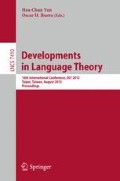Abstract
Pseudopalindromes are words that are fixed points for some antimorphic involution. In this paper we discuss a newer word operation, that of pseudopalindromic completion, in which symbols are added to either side of the word such that the new obtained words are pseudopalindromes. This notion represents a particular type of hairpin completion, where the length of the hairpin is at most one. We give precise descriptions of regular languages that are closed under this operation and show that the regularity of the closure under the operation is decidable.
Access this chapter
Tax calculation will be finalised at checkout
Purchases are for personal use only
Preview
Unable to display preview. Download preview PDF.
References
Cheptea, D., Martín-Vide, C., Mitrana, V.: A new operation on words suggested by DNA biochemistry: Hairpin completion. Trans. Comput., 216–228 (2006)
de Luca, A.: Sturmian words: Structure, combinatorics, and their arithmetics. Theor. Comput. Sci. 183(1), 45–82 (1997)
de Luca, A., De Luca, A.: Pseudopalindrome closure operators in free monoids. Theor. Comput. Sci. 362(1-3), 282–300 (2006)
Diekert, V., Kopecki, S., Mitrana, V.: On the Hairpin Completion of Regular Languages. In: Leucker, M., Morgan, C. (eds.) ICTAC 2009. LNCS, vol. 5684, pp. 170–184. Springer, Heidelberg (2009)
Harrison, M.A.: Introduction to Formal Language Theory. Addison-Wesley, Reading (1978)
Horváth, S., Karhumäki, J., Kleijn, J.: Results concerning palindromicity. J. Inf. Process. Cybern. 23, 441–451 (1987)
Ito, M., Leupold, P., Manea, F., Mitrana, V.: Bounded hairpin completion. Inf. Comput. 209(3), 471–485 (2011)
Kari, L., Kopecki, S., Seki, S.: Iterated Hairpin Completions of Non-crossing Words. In: Bieliková, M., Friedrich, G., Gottlob, G., Katzenbeisser, S., Turán, G. (eds.) SOFSEM 2012. LNCS, vol. 7147, pp. 337–348. Springer, Heidelberg (2012)
Kari, L., Mahalingam, K.: Watson–Crick palindromes in DNA computing. Nat. Comput. 9(2), 297–316 (2010)
Kopecki, S.: On iterated hairpin completion. Theor. Comput. Sci. 412(29), 3629–3638 (2011)
Lothaire, M.: Combinatorics on Words. Cambridge University Press (1962/1997)
Mahalingam, K., Subramanian, K.G.: Palindromic completion of a word. In: BIC-TA, pp. 1459–1465. IEEE (2010)
Manacher, G.: A new linear-time “on-line” algorithm for finding the smallest initial palindrome of a string. Journal of the ACM 22(3), 346–351 (1975)
Manea, F., Martín-Vide, C., Mitrana, V.: On some algorithmic problems regarding the hairpin completion. Discrete Appl. Math. 157(9), 2143–2152 (2009)
Manea, F., Mitrana, V.: Hairpin Completion Versus Hairpin Reduction. In: Cooper, S.B., Löwe, B., Sorbi, A. (eds.) CiE 2007. LNCS, vol. 4497, pp. 532–541. Springer, Heidelberg (2007)
Manea, F., Mitrana, V., Yokomori, T.: Some remarks on the hairpin completion. Int. J. Found. Comput. Sci. 21(5), 859–872 (2010)
Paun, G., Rozenberg, G., Yokomori, T.: Hairpin languages. Int. J. Found. Comput. Sci., 837–847 (2001)
Author information
Authors and Affiliations
Editor information
Editors and Affiliations
Rights and permissions
Copyright information
© 2012 Springer-Verlag Berlin Heidelberg
About this paper
Cite this paper
Fazekas, S.Z., Mercaş, R., Shikishima-Tsuji, K. (2012). Hairpin Completion with Bounded Stem-Loop. In: Yen, HC., Ibarra, O.H. (eds) Developments in Language Theory. DLT 2012. Lecture Notes in Computer Science, vol 7410. Springer, Berlin, Heidelberg. https://doi.org/10.1007/978-3-642-31653-1_38
Download citation
DOI: https://doi.org/10.1007/978-3-642-31653-1_38
Publisher Name: Springer, Berlin, Heidelberg
Print ISBN: 978-3-642-31652-4
Online ISBN: 978-3-642-31653-1
eBook Packages: Computer ScienceComputer Science (R0)

